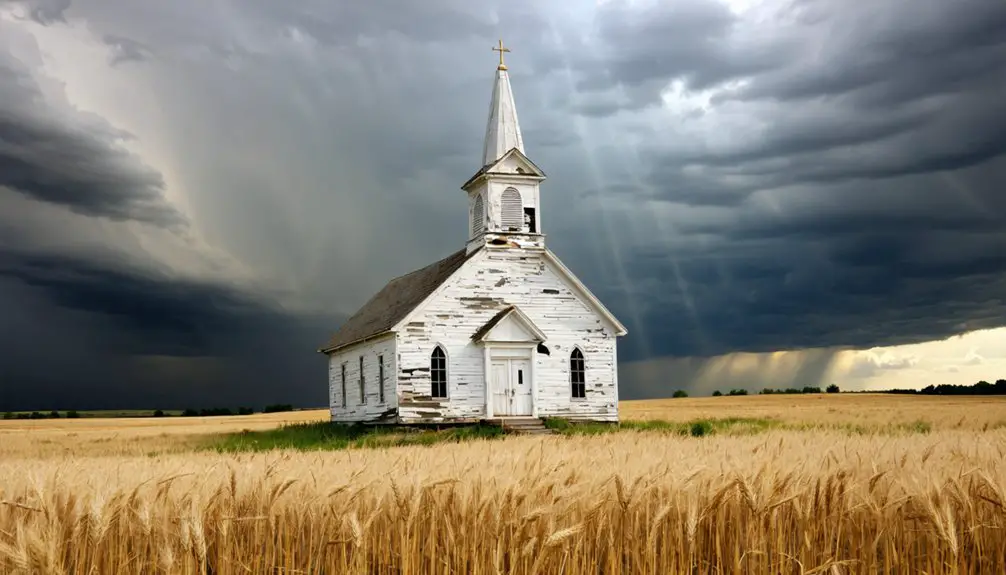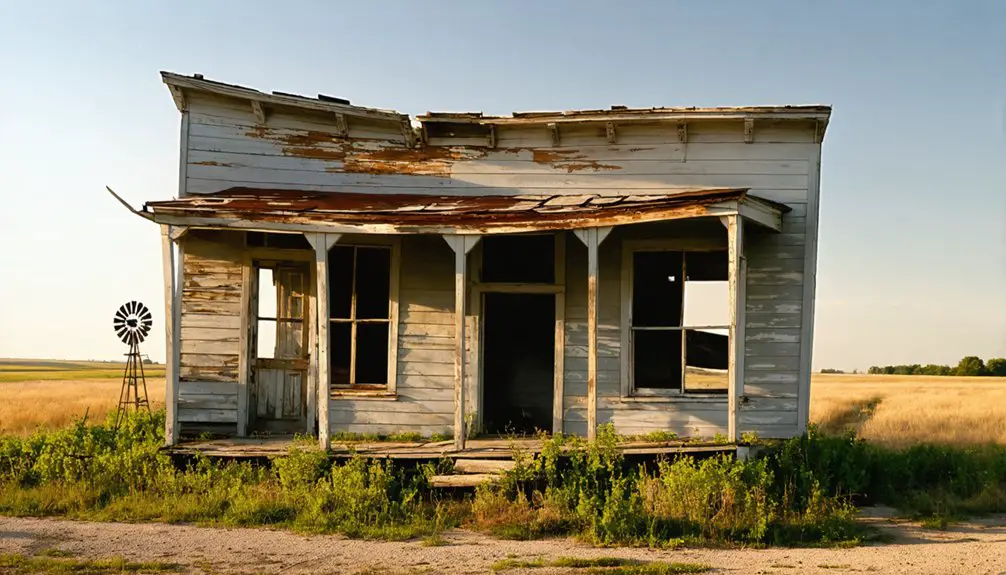You’ll find Woodruff, Kansas at 2,001 feet above sea level between Phillipsburg and Agra, where pioneers first settled in 1862. After the Lincoln Land Company platted the town in 1885, it grew to 300 residents with thriving businesses and an essential post office. Today, only a handful of occupied homes remain, alongside the crumbling walls of the abandoned high school and weathered grain elevators. The town’s silent structures hold fascinating tales of prairie life’s rise and fall.
Key Takeaways
- Woodruff was established in 1885 by the Lincoln Land Company and reached its peak population of 300 residents during railroad expansion.
- The town’s decline began in the early 1900s due to economic factors, agricultural mechanization, and environmental hazards from mining operations.
- The closure of the post office in 1956 and the school in 1964 marked significant milestones in Woodruff’s transformation into a ghost town.
- Today, only two or three homes remain occupied, with most structures deteriorating, including crumbling walls of the abandoned high school.
- Located in Phillips County at 2,001 feet elevation, Woodruff’s remnants serve as a historical reminder of Kansas’s westward expansion era.
The Rise of a Prairie Settlement
As early pioneers ventured into Jewell County in 1862, the land that would become Woodruff saw its first wave of settlement through homesteaders like William Harshberger and John Furrows.
You’ll find their settler experiences marked by determination as they built cabins and cultivated the untamed prairie along White Rock Creek, creating adjacent claims that formed the foundation of a new community.
The spring of 1878 brought promising rains that transformed the short-grass plains into fertile ground, drawing more settlers to stake their claims. Many resourceful pioneers turned to gathering buffalo chips for fuel during harsh winters.
Cultural influences from diverse backgrounds, including Mennonite immigrants in nearby regions, helped shape farming practices and community bonds.
Despite facing Indian hostilities and harsh environmental challenges, these early settlers persisted, though many would later abandon their claims when severe droughts tested their resolve. A visit from hostile Sioux warriors prompted many families to seek safer territories, temporarily halting settlement progress.
Geographical Location and Early Development
Located in Phillips County at coordinates 39°59′34″N and 99°25′35″W, Woodruff emerged as a promising prairie settlement when the Lincoln Land Company platted the town on July 23, 1885.
Phillips County’s Woodruff took root in 1885 when the Lincoln Land Company established this promising prairie town along Kansas’s frontier.
You’ll find this historical landmark perched at 2,001 feet above sea level, between Phillipsburg and Agra. The settlement patterns show how quickly the town grew, as pioneering families from Missouri established trading posts and stores, transforming Woodruff into a bustling community of 300 residents. Much like the case of Woods, Kansas, the town’s eventual decline was tied to the challenges of railroad development failure. Similar to other articles about places named Woodruff, this location required careful disambiguation efforts to distinguish it from similarly named towns.
- The post office’s establishment in 1885 marked Woodruff’s first major infrastructure milestone
- Early settlement concentrated around key trading areas, creating a vibrant commercial district
- The town’s strategic position in the Great Plains initially attracted entrepreneurs seeking opportunity in Kansas’s expanding frontier
Transportation and Economic Growth
When the railroad arrived in Woodruff shortly after its July 1885 founding, the town’s economic prospects soared dramatically.
You’d have seen the population quickly expand to 300 residents as entrepreneurs established new businesses to capitalize on the improved transportation access. The rail connection let local merchants efficiently ship goods to broader markets, transforming Woodruff into a bustling commercial hub.
However, the town’s heavy dependence on rail transport would ultimately contribute to its economic decline. Similar to the Scott Special train run through Kansas in 1905, the rail lines were vital corridors connecting communities to larger cities.
Like many historic Kansas towns such as Bell Plane, Woodruff struggled to maintain its population when residents began seeking better economic opportunities elsewhere.
As transportation influences shifted toward highways and faster rail technologies reduced stops in smaller towns, Woodruff’s commercial relevance diminished.
Like many Kansas towns that couldn’t adapt to changing transportation networks, Woodruff’s fate was sealed when trade routes bypassed the community, leading to its eventual ghost town status.
Community Life and Social Structure
The social fabric of Woodruff extended far beyond its railroad-driven economy, weaving together a tight-knit community of 300 residents at its height. Today’s small population shows a dramatic shift from those bustling days.
You’d have found social institutions at the heart of daily life, with the post office serving as a central gathering point from 1885 until 1956. Community gatherings anchored residents’ lives through churches, schools, and local celebrations that fostered strong bonds among neighbors. Like many towns with distinct geographical locations, Woodruff maintained its unique identity through local customs and traditions.
- Family networks formed the backbone of mutual support, particularly essential in agricultural pursuits.
- Religious services and school activities created regular opportunities for social connection.
- Local traditions and shared cultural experiences unified the mainly rural population.
Agriculture and Local Industries
Farming shaped Woodruff’s destiny from its 1885 founding through its eventual decline. You’d have found the town thriving after the railroad’s arrival, with nearly 300 residents supporting a bustling agricultural economy. Like many Kansas towns, they primarily shipped grain and livestock from local farms.
The lack of crop diversification left Woodruff vulnerable when mechanization impact transformed farming practices. The Dust Bowl and Depression dealt devastating blows to local farmers, forcing many to abandon their land. As hybrid seeds and advanced irrigation boosted productivity, fewer farmers could manage larger plots of land.
The town’s crucial services – from grain elevators to mills – couldn’t survive as agricultural operations consolidated. You’ll notice how mechanization’s ripple effects touched every aspect of local life.
When farm families moved away, businesses followed. The railroad that once exported local grain and livestock became less essential as road transport expanded, leaving Woodruff to fade into Kansas’s landscape of ghost towns.
Natural Disasters and Environmental Challenges
Mining operations beneath Woodruff’s foundations created a legacy of environmental hazards that would plague the town for generations.
You’ll find the area’s most pressing challenges stemmed from abandoned mine tunnels that created dangerous sinkholes, threatening buildings and infrastructure. The town’s soil and groundwater became contaminated with toxic heavy metals from mining waste, while dust containing lead particles posed serious health risks to residents.
- Underground voids from mining operations led to frequent ground collapses near critical town structures
- Lead and zinc contamination from mine waste piles infiltrated local water sources and soil
- Airborne mining waste particles created ongoing exposure risks through dust on roads and disturbed areas
These mining impacts contributed greatly to Woodruff’s eventual decline, as environmental hazards made the area increasingly unsuitable for habitation.
Decline and Population Loss

Beyond the environmental challenges, Woodruff faced a devastating population exodus that began in the early 1900s. Economic factors, including the discovery of cheaper coal sources elsewhere in Kansas and increased agricultural mechanization, severely impacted the town’s sustainability.
You’d have seen dramatic demographic changes as strip mining operations closed and farming required fewer workers.
The town’s decline accelerated with the closure of critical institutions. By 1964, Woodruff’s school had shut down, marking a pivotal moment in the community’s deterioration.
Woodruff’s fate was sealed when its school closed in 1964, signaling the final chapter for this once-thriving Kansas community.
The loss of essential services, including the post office and local businesses, prompted residents to seek opportunities elsewhere. What was once a vibrant community supported by mining and agriculture dwindled considerably, following a pattern common to many Kansas towns that couldn’t adapt to changing economic realities.
Modern-Day Remnants and Ruins
Today in Woodruff, you’ll find a haunting collection of deteriorating structures that tell the story of its former liveliness. The urban decay has claimed most buildings, with only two or three homes still occupied among the architectural remnants.
You can spot old grain elevators standing as silent sentinels of the town’s agricultural past, while former railroad tracks lay dormant, slowly disappearing beneath encroaching grass and wildflowers.
- Abandoned high school walls crumble beneath Kansas skies, leaving behind fragments of a once-bustling educational center.
- Street signs still mark phantom intersections where roads have vanished under decades of natural reclamation.
- Historic buildings, including the former post office, stand in various states of collapse, offering glimpses into the community’s earlier vibrancy.
Historical Significance and Legacy

The story of Woodruff mirrors countless other Kansas towns that emerged during the ambitious westward expansion of the 19th century.
Westward expansion birthed countless frontier towns like Woodruff, each one a testament to Kansas’s pioneering spirit.
You’ll find its cultural heritage woven into the broader tapestry of pioneer life, where churches, schools, and community gatherings once formed the backbone of daily existence.
Like many of its neighboring settlements, Woodruff faced the harsh realities of drought, economic shifts, and changing transportation routes that ultimately led to its decline.
Historical preservation efforts have maintained fragments of Woodruff’s past through local museums, cemeteries, and oral histories.
While the town’s physical structures may have largely disappeared, its legacy lives on as a monument to the determination of early settlers who braved environmental challenges and economic uncertainty to build communities across Kansas’s frontier landscape.
Frequently Asked Questions
Were Any Famous Outlaws or Historical Figures Known to Visit Woodruff?
Despite rumors during the turbulent Kansas-Missouri border wars, you won’t find any confirmed outlaw sightings or historical visits to this area. All reported threats proved false, causing founder Brooks’ temporary departure.
What Native American Tribes Originally Inhabited the Area Before Woodruff’s Establishment?
You’ll find the Kaw (Kanza) tribe were the primary Native inhabitants of this region, with historical significance extending across northern Kansas, while Pawnee and Osage tribes also traversed these lands.
Did Woodruff Have Any Unique Local Customs or Annual Celebrations?
You won’t find documented unique local traditions or festival highlights for Woodruff. Like other small Kansas railroad towns, they likely gathered for church events, harvest celebrations, and social dances, but specific customs weren’t recorded.
What Was the Highest Recorded Population of Woodruff During Its Peak?
You won’t find exact peak population records, but based on regional population trends and historical significance of similar Kansas ghost towns, estimates suggest Woodruff likely peaked between 100-400 residents before declining.
Are There Any Ghost Stories or Local Legends Associated With Woodruff?
You won’t find documented ghost sightings or established local folklore from Woodruff, though neighboring towns have rich supernatural tales. The town’s dramatic decline and railroad rivalries could’ve spawned legends, but they’re lost now.
References
- https://www.youtube.com/watch?v=iB5rHT14eVI
- https://www.youtube.com/watch?v=gkfXLg-ftys
- https://www.hhhistory.com/2019/05/ghost-towns-of-kansas.html
- https://www.youtube.com/watch?v=OyBXD18P_j4
- https://legendsofkansas.com/kansas-ghost-town-list/
- http://www.ksgenweb.org/archives/jewell/history/1878/
- https://www.kspatriot.org/index.php/library-home/544-settlement-of-southwest-kansas.html
- https://legendsofkansas.com/wilson-county-kansas/
- https://fhsuguides.fhsu.edu/kansasheritage/phillipscounty
- https://www.americanheritage.com/mennonites-come-kansas



